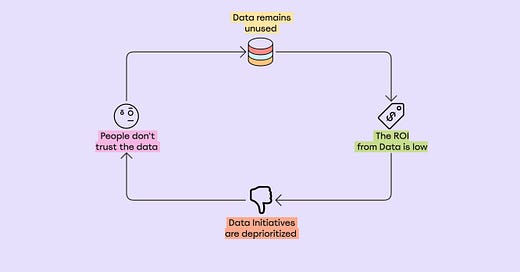Hey friend, welcome to the databeats newsletter.
databeats provides data education for growth practitioners via honest, accessible content – don’t forget to check out our free learning hub!
I’ve been spreading the gospel of Good Data ever since I launched the GDG (Good Data to Growth) model.
But what exactly do I mean by Good Data? Let me explain.
A piece of data can be either good or bad depending on how useful it is and how accurately it helps convey information.
Similarly, a data infrastructure or a data stack can be good, bad, or something in between, depending on how the components – the tools or pieces of infrastructure – are assembled.
The data foundation, the way I see it, is a combination of processes and systems that are put in place to support the data infrastructure (to make sure it doesn’t come apart).
Distinct from data infrastructure or the data itself, data foundation can also be good (well-designed and robust) or bad (poorly designed and fragile).
The capitalized “Good Data”, therefore, refers to a robust data foundation which, as depicted in the GDG model below, starts with context.
Now what is good event data?
I recently collaborated with João Lousada, a data professional at a well-known SaaS behemoth, to answer that question and discuss the role of data governance in collecting good event data.
Here’s a summary of the guide that we published on the learning hub:
Data Governance is much more than collecting data in a compliant way. It's about ensuring its accuracy, understandability, and relevance. Here are the three properties of data governance that lead to good event data:
Accurate: Maintaining a clean tracking plan, schema enforcement, and quality assurance are all vital steps.
Understandable: Consistent naming conventions, comprehensive documentation, and an intuitive user experience bridge the gap between raw data and actionable insights.
Relevant: Aligning data tracking with business objectives and regularly measuring key metrics ensures the data's significance and overall impact on data culture.
João also talks about a vicious cycle (which reminded me of the GDG antithesis) that a lack of data governance leads to – I call it the cycle of data distrust.
Now, even when a data team successfully makes good event data available in downstream tools used by data-adjacent teams (a collective term for product, growth, and marketing teams), it’s hard to avoid discrepancies when consuming data in external tools.
But why do discrepancies take place?
I recently collaborated with Barbara Galiza, a data and growth expert who says, “Data discrepancies are to be expected since different sources capture, interpret, and model data in different ways. However, if discrepancies are not addressed, they can cause a slew of challenges for organizations.”
Barbara’s guide discusses common marketing data sources and associated discrepancies, proposes some solutions, and tells us how she stopped worrying about and started loving discrepancies.
Alright! Can a post about event data do without talking about data activation?
Maybe, but not this one!
I’ve written a ton about data activation, one of the two key things that event data is used for.
During my growth days, before data warehousing went mainstream, real-time data activation – or triggering campaigns in real time – was taken for granted. For me, event data has always been a beautiful construct because it enables me to act upon an event the moment it takes place (in real time).
However, with the rise of the data warehouse, companies faced a dilemma: whether to sync events from a source directly to downstream tools or make everything pass through the data warehouse, in which case, triggering campaigns in real time, within seconds of an event taking place, wasn’t quite possible.
Well, that’s no longer the case because the good folks at Census – the ones that brought us Reverse ETL – recently launched Live Syncs, a new product that pairs with a real-time data source (like Kafka or Materialize) to enable Reverse ETL in real time.
In fancier terms, they have taken Warehouse-native Real-time Data Activation from idea to reality. 🥁 🥁
The Census team partnered with databeats to tell the story* of how their core product has evolved since its launch in 2018 to keep up with the evolution in customer data technology, leading up to the launch of Live Syncs.
*This is a sponsored post.
Finally, a 30-minute playlist perfect for your next nature walk 🌴






